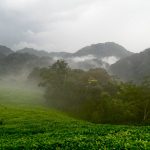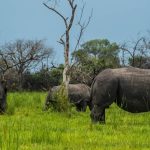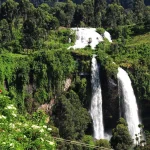Located in southwestern Uganda, near the border with Rwanda in Kabale District, Lake Bunyonyi serves as an idealized retreat for meditation and relaxation. Its existence traces back to the era when a volcanic explosion created a valley filled with water to form the lake. Lake Bunyonyi ranks among the deepest lakes in Africa, offering the surrounding region a consistently cool climate throughout the year, complemented by ample rainfall that nurtures the lush green hills encircling the lake
The name “Bunyonyi” means “a place with little birds.” This nomenclature resonates that the place harbors avian life thus creating a haven for ornithophiles. Lake Bunyonyi is an ideal destination for relaxation, especially after game viewing or gorilla tracking from the renowned national parks like Bwindi Impenetrable, Mgahinga and Queen Elizabeth National Park.
Islands on Lake Bunyonyi

Lake Bunyonyi is made up of 29 islands with 5 popular which include punishment Island ‘Akampene’, Bwama, Njuyeera ‘sharp island’, Bushara, Bucuranuka ‘upside down island’
Akampeene Island
Within Lake Bunyonyi there is an island with a dark historical chapter known as Akampene, or “Punishment Island.” This tiny isle is covered in tales of despair and was once a haunting symbol of societal judgment, especially for unmarried pregnant women.
This cruel practice persisted until the 1940s, when women found in the delicate situation of unmarried pregnancy were abandoned on Akampene. Isolated and forsaken, these women faced a grim fate by starving or drowning in the perilous attempt to swim back to the mainland. Swimming skills were rare, adding to the severity of their sorry situation. Yet, some were spared from this misery by the compassion of impoverished men or slaves who, unaffected by societal stigmas, offered a lifeline to these women.

The origins of this harrowing tradition can be traced back to a harsh mindset that sought to punish perceived moral crimes. It wasn’t until the 1940s that the influence of missionaries, particularly in the villages of Bwama and Njuyeera, began to challenge and ultimately dismantle this practice.
Italian documentary maker Laura Cini has dedicated herself to recording the haunting legacy of Punishment Island since 2011. Through her lens, she captures the resilience of survivors, including interviews with women who were rescued from the island for instance; Mrs Mauda Kyitaragambirwe. Their stories provide a touching testament to the strength of the human spirit in the face of adversity.
Beyond Lake Bunyonyi, the region witnessed equally brutal practices. In some areas, girls faced even graver consequences, including being tied up to trees in forests, abandoned to the mercy of wild animals, or thrown over cliffs at locations like Kisiizi Falls or Nyabugoto Cave. Lake Mutanda also bore witness to its own version of Punishment Island.
The ritual of punishment extended beyond mere isolation and it also involved brutal interrogations where the victim would be beaten until she revealed the name of the father. If the father hailed from the same clan, he faced the dire choice of escaping or meeting a frightful fate, often finding refuge in another clan. However, if from a different clan, societal norms dictated a forced marriage between the two.
Upon seeking forgiveness and reconciliation, a symbolic act unfolded as the repentant woman, upon returning to her parents’ home, entered through a side entrance with her back turned, offering a sheep as a gesture of repentance. The resolution culminated in the payment of the bride price, solidifying the redemption of the woman in the eyes of her community. Notably, the man involved was spared punishment unless the woman’s family sought retribution.
Bwama and Njuyeera Island
In 1921, an English missionary named Leonard Sharp arrived in Uganda with a compassionate mission. About ten years later, in 1931, he established a leprosy treatment center on the deserted Bwama Island. This place would soon become a place for those affected by leprosy.

On Bwama Island, Leonard Sharp initiated the construction of essential facilities such as a church, homes for patients (referred to as model villages), and a medical facility. Meanwhile, Sharp himself settled on a neighboring island called Njuyeera, which is believed to mean “white cottage.” The name likely came from the small white house that resembled Sharp’s father’s residence in Shanklin, now known as The White House Hotel.
The idea was to create a welcoming and happy community on Bwama Island, hoping to attract leprosy sufferers. By doing so, the intention was to remove them from mainstream communities where there was a fear of infecting others.
Leonard Sharp’s approach was rooted in empathy, aiming to provide not only medical care but also a supportive environment for those facing the challenges of leprosy. The model villages and the medical facilities were designed to foster a sense of community and help those affected live fulfilling lives. This showed a humanitarian approach to dealing with leprosy.
Things to do at lake Bunyonyi
Swimming
Lake Bunyonyi’s water is clean and free from pollution, crocodiles, hippos, and Bilharzia parasites, thus offering a refreshing swimming experience. Caution is advised due to the lake’s depth, making it necessary for non-swimmers to be mindful. Alternatively, hotel swimming pools provide a safer option.
Canoeing

Tourists can only get around the lake and its islands through canoeing by using locally-made canoes that are carved from large trees or by utilizing motor engines. Canoes for rent are always available on shores for rent. Early morning canoeing with mist-covered waters are offered and night canoeing can be arranged for a unique experience under the cool night breeze.
Community and Cultural Visits

One of the popular activities done around lake Bunyonyi is community and cultural walks where tourists take walks to engage with local life near the lake, mingling with residents, and participating in daily tasks. Visit local schools, try traditional activities like hoeing the garden, or venture into the rich cultural experiences of the Bakiga people. There is also an alternative of visiting the Batwa people who were removed from Echuya forest offers a glimpse to cultural heritage through dance, songs, and storytelling.
Nature Walks
Lake Bunyonyi offers guided hikes along established trails to the terraced hills and panoramic views of the lake. Tourists explore the ancient bamboo forest of Echuya or smaller ones surrounding the lake, offering encounters with small primates and zebras.
Mountain Biking

Lodges around lake Bunyonyi these such activities where tourists are accompanied by the guide to lead them in cycling in the landscapes and human settlements. These mountain bikes can be rented through a tour company or lodges.
Visit the Local Market
Experience the vibrant local market in Rutindo on Mondays and Fridays, where residents gather to buy and sell fresh produce.tourists immerse in the daily life of the locals, interact with them, and enjoy the lively atmosphere.
Birdwatching
Lake Bunyonyi is a home to over 205 bird species, including resident and migratory birds, the lake’s islands serve as sanctuaries. During boat cruises tourists are able to spot egrets, weaverbirds, herons, grey crowned cranes, and more.
Eating Crayfish

The infamous Louisiana Crayfish were introduced to Lake Bunyonyi during Idi Amin’s rule. These crayfish have become a culinary delight, dominating the lake’s waters. Indulge in this local specialty or opt for the delicious Tilapia fish available at lodges and restaurants.
Getting to Lake Bunyonyi
By road from Kampala to reach Lake Bunyonyi one can use Mbarara-Masaka road and Kabale Mbarara road that is 499 km (9 hrs and 30 mins drive). There is a well-maintained dirt road connecting Kabale to Rutinda, if you’re navigating the journey independently, follow the Kisoro road out of Kabale for 500 meters. Shortly after passing a Kobil filling station, make a left turn at a junction marked by several signposts directing you to lakeshore resorts. After approximately 5 kilometers, the road ascends to the hill overlooking Bunyonyi, presenting a five-way junction. For Acacia Cottages, turn left; otherwise, continue straight ahead to reach Rutinda after an additional 2 kilometers.
The road branching right at this junction offers views of the lake and leads to Muko on the main Kabale–Kisoro road after about 20 kilometers.
 For those bound for Bushara Island, secure parking is available at the island’s compound in Rutinda.
For those bound for Bushara Island, secure parking is available at the island’s compound in Rutinda.
Regular minibus taxis and pick-up trucks, priced at 5,000 shillings, run between Kabale and Rutinda on market days (Monday and Friday), but the service may be irregular on other days. A special hire to Rutinda should cost around 50,000 shillings, while a boda-boda ride is approximately half that.
If you prefer a more leisurely journey, consider walking along the described road, with the possibility of hitching a lift. Alternatively, take the Butambuka Road west out of the town center, following local footpaths. Villagers are readily available to guide you in the right direction.
Regardless of the chosen route, the walk is a rewarding experience in itself, passing through traditional homesteads and patches of forest alive with birdlife. The journey takes around two hours, featuring a challenging ascent as you approach the summit above the lake.
It is advisable to avoid hiring a push bicycle to reach Bunyonyi, as the steep hills may necessitate as much time spent pushing the bike as cycling.
By air, one can fly from Entebbe airport to Kisoro airstrip which takes about 1 to 2 hrs and follow Kisoro-Kabale road. However, lake Bunyonyi is closer to Kigali (Rwanda) than Kampala and it takes 3 hours of driving by car to reach the destination.








